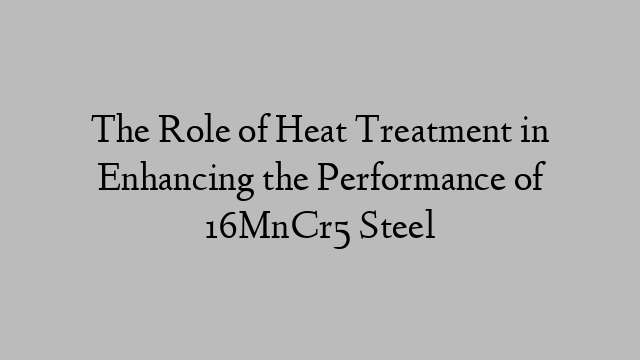Address
304 North Cardinal St.
Dorchester Center, MA 02124
Work Hours
Monday to Friday: 7AM - 7PM
Weekend: 10AM - 5PM
Address
304 North Cardinal St.
Dorchester Center, MA 02124
Work Hours
Monday to Friday: 7AM - 7PM
Weekend: 10AM - 5PM

Heat treatment plays a crucial role in enhancing the performance of 16MnCr5 steel by improving its mechanical properties and optimizing its chemical composition.
16MnCr5 steel is a low alloyed steel commonly used in applications that require high toughness and wear resistance, such as gears, shafts, and cams. However, the as-received steel may not possess the desired mechanical properties and chemical composition to meet specific performance requirements.
Heat treatment processes, such as annealing, normalizing, quenching, and tempering, can be applied to 16MnCr5 steel to modify its microstructure and improve its mechanical properties. For example, annealing the steel at a specific temperature and holding it for a certain duration can help refine the grain structure, making it more uniform and reducing the presence of impurities or defects. This can lead to improved mechanical properties, such as increased ductility and toughness.
Quenching, on the other hand, involves rapidly cooling the steel from a high temperature to room temperature using a quenching medium, such as oil or water. This process causes the formation of a hard and brittle martensite structure, which significantly increases the hardness and strength of the steel. However, the brittleness of martensite can be detrimental to its performance, making it necessary to temper the quenched steel. Tempering involves reheating the quenched steel to a specific temperature and holding it for a certain duration to reduce the brittleness and improve the toughness without compromising too much of the hardness and strength gained from quenching.
In addition to modifying the microstructure and mechanical properties, heat treatment can also be used to optimize the chemical composition of 16MnCr5 steel. For example, it is possible to alter the carbon content during the annealing process, which can influence the hardness and strength of the steel. Controlling the chemical composition is vital because it affects how the steel responds to heat treatment and its overall performance characteristics.
Overall, heat treatment is an essential process in enhancing the performance of 16MnCr5 steel. By carefully selecting and applying different heat treatment techniques, the mechanical properties can be improved, and the chemical composition can be optimized to meet specific performance requirements.
16MnCr5 Steel grade
1698341616